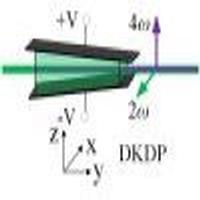当前位置:
X-MOL 学术
›
Opt. Lett.
›
论文详情
Our official English website, www.x-mol.net, welcomes your feedback! (Note: you will need to create a separate account there.)
Adiabatic nonlinear optical frequency conversion based on the electro-optic effect
Optics Letters ( IF 3.6 ) Pub Date : 2020-01-10 , DOI: 10.1364/ol.377024 Xun Liu , Xueju Shen , Ting Rui , Lei He , Bing Zhou , Nan Zheng
Optics Letters ( IF 3.6 ) Pub Date : 2020-01-10 , DOI: 10.1364/ol.377024 Xun Liu , Xueju Shen , Ting Rui , Lei He , Bing Zhou , Nan Zheng

|
We propose a novel, to the best of our knowledge, adiabatic nonlinear optical frequency conversion method based on the electro-optic effect, which can be applied in a plethora of bulky nonlinear crystals. Within our method, an electric field gradient is applied on the crystal, which causes the phase mismatch to also gradually vary in space, thus achieving adiabatic frequency conversion. We demonstrate the validity and feasibility of this new approach by providing a theoretical framework and experimental evidence. In the experiment, the second harmonic generation of 532 nm is conducted in ${{\rm KD}_2}{{\rm PO}_4}$. Conversion efficiency approaching 47.2% is achieved, with a corresponding temperature acceptance bandwidth of 4.56°C, which is about 4.3 times the temperature without the external electric field. We argue that the approach based on the electro-optic effect is promising for extending the range of applications of adiabatic frequency conversion and, consequently, for achieving efficient and robust frequency conversion.
中文翻译:

基于电光效应的绝热非线性光学变频
据我们所知,我们提出了一种基于电光效应的绝热非线性光学频率转换方法,该方法可用于大量庞大的非线性晶体中。在我们的方法中,在晶体上施加电场梯度,这会导致相位失配在空间上也逐渐变化,从而实现绝热频率转换。通过提供理论框架和实验证据,我们证明了这种新方法的有效性和可行性。在实验中,以$ {{\ rm KD} _2} {{\ rm PO} _4} $。转换效率达到47.2%,相应的温度接受带宽为4.56°C,约为没有外部电场的温度的4.3倍。我们认为,基于电光效应的方法有望扩展绝热频率转换的应用范围,从而实现高效,鲁棒的频率转换。
更新日期:2020-01-15
中文翻译:

基于电光效应的绝热非线性光学变频
据我们所知,我们提出了一种基于电光效应的绝热非线性光学频率转换方法,该方法可用于大量庞大的非线性晶体中。在我们的方法中,在晶体上施加电场梯度,这会导致相位失配在空间上也逐渐变化,从而实现绝热频率转换。通过提供理论框架和实验证据,我们证明了这种新方法的有效性和可行性。在实验中,以$ {{\ rm KD} _2} {{\ rm PO} _4} $。转换效率达到47.2%,相应的温度接受带宽为4.56°C,约为没有外部电场的温度的4.3倍。我们认为,基于电光效应的方法有望扩展绝热频率转换的应用范围,从而实现高效,鲁棒的频率转换。


























 京公网安备 11010802027423号
京公网安备 11010802027423号